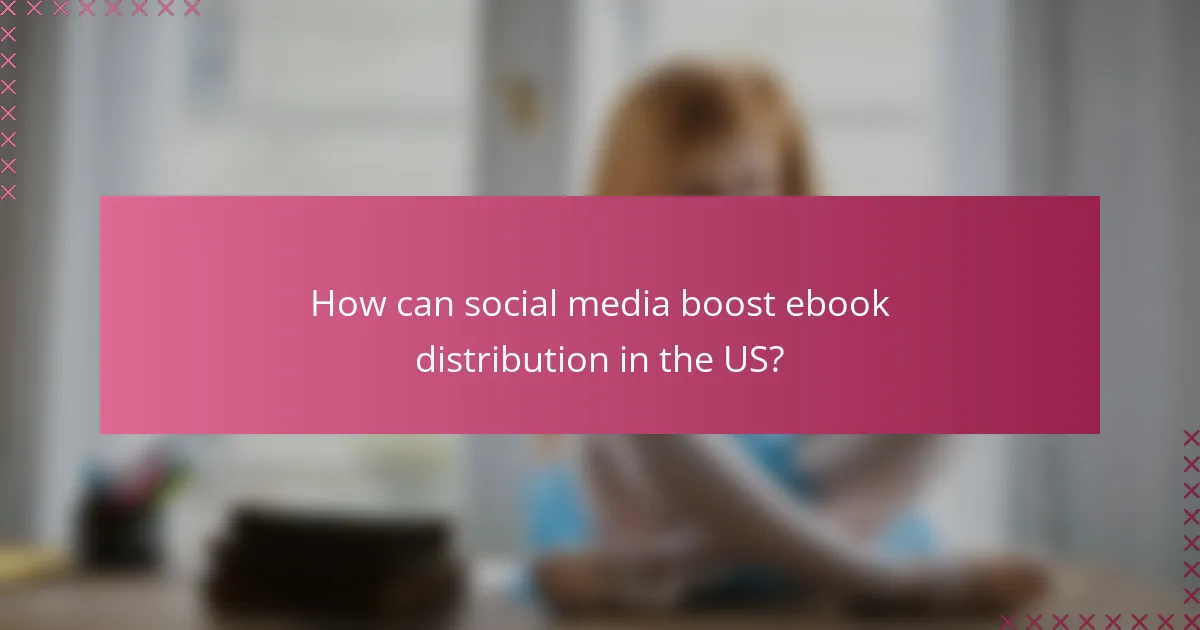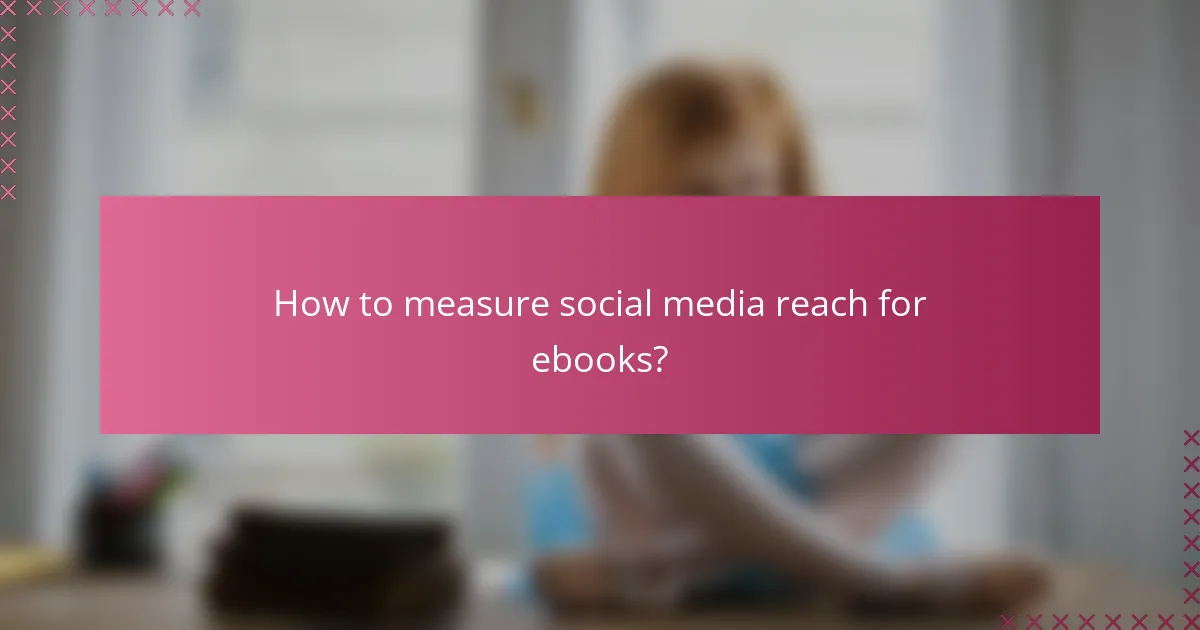In today’s digital landscape, social media plays a crucial role in enhancing ebook distribution by boosting visibility and fostering engagement with potential readers. By employing targeted strategies across various platforms, authors and publishers can create interactive experiences that not only connect with audiences but also drive sales. Understanding and measuring social media reach is essential for optimizing promotional efforts and ensuring the success of ebook campaigns.

How can social media boost ebook distribution in the US?
Social media can significantly enhance ebook distribution in the US by increasing visibility and engagement with potential readers. By leveraging various platforms, authors and publishers can reach targeted audiences, foster connections, and drive sales effectively.
Targeted advertising on Facebook
Facebook’s targeted advertising allows you to reach specific demographics based on interests, behaviors, and location. This precision can help you connect with readers who are most likely to be interested in your ebook. Consider setting a budget of a few hundred dollars to start, testing different ad formats like carousel or video ads to see what resonates best.
Utilize Facebook’s analytics tools to track engagement and conversion rates, adjusting your campaigns as needed. A/B testing different headlines and images can also provide insights into what attracts your audience’s attention.
Engagement through Instagram Stories
Instagram Stories offer a dynamic way to engage with your audience through visuals and short videos. You can share sneak peeks of your ebook, behind-the-scenes content, or reader testimonials to create buzz. Use interactive features like polls or questions to encourage audience participation and feedback.
Post consistently and utilize relevant hashtags to expand your reach. Aim for a mix of promotional and engaging content to keep your followers interested and invested in your ebook’s journey.
Utilizing Twitter for real-time updates
Twitter is ideal for sharing real-time updates about your ebook, such as launch dates or special promotions. Use concise, engaging tweets to capture attention, and consider using threads to provide more detailed information. Engaging with followers through retweets and replies can also foster a sense of community.
Participate in relevant hashtags or Twitter chats to connect with potential readers and industry professionals. Keeping your tweets frequent and varied can help maintain visibility in a fast-paced environment.
Leveraging LinkedIn for professional audiences
LinkedIn is a powerful platform for reaching professional audiences, especially if your ebook targets business or industry-specific topics. Share articles, excerpts, or insights related to your ebook to establish authority and attract interest. Joining relevant groups can also expand your network and visibility.
Consider using LinkedIn’s publishing platform to share longer content that highlights your expertise, linking back to your ebook for further reading. Engaging with other professionals through comments and shares can enhance your credibility and encourage discussions around your work.

What are effective engagement strategies for ebooks?
Effective engagement strategies for ebooks focus on creating interactive experiences that foster reader participation and connection. By utilizing various methods such as interactive content, live sessions, and user-generated contributions, authors can significantly enhance reader involvement and promote their ebooks more effectively.
Creating interactive content
Interactive content, such as quizzes, polls, and embedded videos, can captivate readers and encourage them to engage more deeply with the material. For instance, including a quiz at the end of an ebook chapter can reinforce key concepts and make the reading experience more enjoyable.
When designing interactive elements, ensure they are easy to access and navigate. Tools like Google Forms or Typeform can be used to create engaging quizzes, while platforms like Canva can help design visually appealing graphics that complement the text.
Hosting live Q&A sessions
Live Q&A sessions provide an opportunity for readers to interact directly with the author, fostering a sense of community and connection. These sessions can be hosted on platforms like Facebook Live or Instagram, allowing for real-time engagement and feedback.
To maximize participation, promote the event across your social media channels and consider scheduling it at a time convenient for your target audience. Prepare a few questions in advance to kickstart the conversation and keep the session flowing smoothly.
Encouraging user-generated content
Encouraging readers to create and share their own content related to your ebook can amplify its reach and engagement. This could include asking readers to share their thoughts on social media, post reviews, or create fan art inspired by the book.
To incentivize participation, consider running contests or offering rewards for the best submissions. This not only boosts engagement but also creates a sense of ownership among readers, making them more likely to promote your ebook within their networks.

How to measure social media reach for ebooks?
Measuring social media reach for ebooks involves tracking how many people see your content across various platforms. This data helps you understand your audience’s engagement and the effectiveness of your promotional strategies.
Using analytics tools like Google Analytics
Google Analytics is a powerful tool for measuring social media reach. By setting up tracking for your ebook’s landing page, you can monitor traffic sources, user behavior, and the overall effectiveness of your social media campaigns.
To get started, ensure you have the correct UTM parameters in your social media links. This allows Google Analytics to attribute traffic accurately, enabling you to see which platforms drive the most visitors to your ebook.
Tracking engagement metrics on social platforms
Engagement metrics such as likes, shares, comments, and clicks are crucial for understanding your ebook’s reach on social media. These metrics indicate how well your content resonates with your audience.
Most social media platforms provide built-in analytics tools. For instance, Facebook Insights and Twitter Analytics offer detailed reports on post performance, helping you identify which types of content generate the most engagement.
Assessing conversion rates from social media
Conversion rates measure how many social media users take a desired action, such as downloading your ebook or signing up for a newsletter. This metric is vital for evaluating the effectiveness of your social media strategy.
To calculate conversion rates, divide the number of conversions by the total number of visitors from social media and multiply by 100. A conversion rate of 2-5% is generally considered good, but this can vary by industry and audience.

What are the best platforms for ebook promotion?
The best platforms for ebook promotion include Amazon Kindle Direct Publishing, Smashwords, and Gumroad. Each platform offers unique advantages, catering to different distribution needs and sales strategies.
Amazon Kindle Direct Publishing
Amazon Kindle Direct Publishing (KDP) is a leading platform for ebook promotion, allowing authors to publish and sell their books directly on Amazon. KDP offers a vast audience, with millions of potential readers, and provides tools for marketing, such as Kindle Unlimited and promotional pricing.
When using KDP, consider enrolling in KDP Select, which can enhance visibility through promotional opportunities. However, this requires exclusivity to Amazon for a period, so weigh the benefits against the limitations of wider distribution.
Smashwords for wider distribution
Smashwords is an excellent choice for authors seeking broader distribution beyond Amazon. It enables ebook distribution to multiple retailers, including Apple Books, Barnes & Noble, and Kobo, increasing the chances of reaching diverse audiences.
Authors should focus on formatting their ebooks according to Smashwords’ guidelines to ensure smooth publication. Additionally, utilizing Smashwords’ marketing tools, such as coupons and promotional listings, can enhance visibility across various platforms.
Gumroad for direct sales
Gumroad allows authors to sell ebooks directly to consumers, providing a straightforward platform for managing sales and customer relationships. This approach enables authors to retain a larger percentage of sales revenue compared to traditional publishing platforms.
To maximize success on Gumroad, authors should leverage social media and email marketing to drive traffic to their sales pages. Offering limited-time discounts or exclusive content can also incentivize purchases and build a loyal customer base.

What criteria should be considered for social media strategy?
When developing a social media strategy for ebook distribution, key criteria include understanding your target audience, selecting suitable content types, and determining budget allocation for advertisements. These elements are crucial for maximizing engagement and reach across various platforms.
Target audience demographics
Identifying the demographics of your target audience is essential for tailoring your social media strategy. Consider factors such as age, gender, location, and interests, as these will influence the platforms you choose and the content you create. For example, younger audiences may prefer platforms like TikTok or Instagram, while older demographics might engage more on Facebook.
Utilize analytics tools to gather insights about your audience’s behavior and preferences. This data can guide your content creation and posting schedule, ensuring that you reach your audience when they are most active.
Content type suitability
Different types of content resonate with audiences on various social media platforms. For instance, visually appealing graphics and short videos often perform well on Instagram, while longer articles or discussions may be better suited for Facebook or LinkedIn. Understanding what type of content your audience prefers can significantly enhance engagement.
Experiment with various formats such as infographics, live videos, and user-generated content to see what drives the most interaction. Regularly assess the performance of your content to refine your strategy and focus on what works best.
Budget allocation for ads
Allocating a budget for social media advertising is critical for expanding your reach beyond organic followers. Start by determining a percentage of your overall marketing budget to dedicate to social media ads, typically ranging from 10% to 30%. This investment can help increase visibility and drive sales for your ebooks.
Consider the cost-effectiveness of different platforms. For example, Facebook ads may offer robust targeting options, while Instagram ads can be visually impactful. Monitor your ad performance and adjust your budget allocation based on which platforms yield the best return on investment.

What are common pitfalls in ebook social media marketing?
Common pitfalls in ebook social media marketing include failing to engage the audience, neglecting consistent branding, and not utilizing analytics effectively. These mistakes can hinder the reach and impact of your ebook promotion efforts.
Neglecting audience engagement
Neglecting audience engagement can severely limit the success of your ebook marketing strategy. Engaging with your audience fosters a sense of community and encourages them to share your content, which can significantly expand your reach.
To enhance engagement, respond to comments, ask questions, and create polls related to your ebook’s theme. For instance, if your ebook is about healthy cooking, you might post a question about favorite recipes or cooking tips, inviting followers to share their thoughts.
Do not overlook the importance of regular interaction. Aim to post consistently and actively engage with followers at least a few times a week. This approach helps maintain interest and keeps your audience connected to your content, ultimately driving more downloads and sales.
